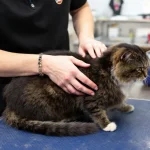Fear aggression in cats is a defensive behavior triggered by feelings of fear or threat. Unlike offensive aggression, where a cat might actively seek to dominate, fear aggression occurs when a cat feels cornered or perceives no other option but to defend itself. Understanding the causes, signs, and solutions can help you manage and reduce this behavior.
Causes of Fear Aggression
Traumatic Experiences
A past negative encounter, such as abuse, being chased, or loud noises, can make a cat fearful of certain people, animals, or situations.
Lack of Socialization
Cats that weren’t exposed to various people, pets, or environments during their kittenhood may be more prone to fear aggression as adults.
Unfamiliar Stimuli
New environments, strange people, or other animals can overwhelm a cat, triggering a defensive response.
Veterinary Visits or Handling
Fear aggression often occurs during situations where a cat feels restrained, such as at the vet or during grooming.
Health Issues
Pain or illness can heighten a cat’s sense of vulnerability, leading to defensive aggression when approached.
Signs of Fear Aggression
Fear-aggressive cats will exhibit both defensive and offensive body language as a way to warn others to stay away:
Body Posture:
Arched back or crouched position, trying to appear smaller or larger depending on the situation.
Ears:
Flattened ears pressed back against the head.
Eyes:
Dilated pupils with a wide-eyed or glaring expression.
Tail:
Tucked under the body or puffed up and lashing.
Vocalizations:
Growling, hissing, spitting, or yowling.
Behavioral Signs:
Swatting, biting, scratching, or lunging if approached.
How to Manage Fear Aggression
Identify the Trigger
Observe your cat’s behavior to determine what’s causing the fear, whether it’s a specific person, animal, noise, or environment.
Give Space
Avoid forcing interaction. Fear-aggressive cats need time to calm down and feel secure.
Desensitization and Counterconditioning
Gradually expose your cat to the trigger in a controlled, non-threatening way. Pair the exposure with positive rewards like treats or play to create a new, positive association.
Provide Safe Spaces
Create hiding spots or quiet zones where your cat can retreat when feeling overwhelmed.
Use Calming Aids
Products like Feliway (a synthetic cat pheromone) can help reduce anxiety. Additionally, calming treats or supplements may be beneficial.
Avoid Punishment
Punishing a fearful cat can escalate their aggression and worsen the problem. Focus on building trust instead.
When to Seek Professional Help
If fear aggression persists or worsens, consult a veterinarian or a certified animal behaviorist. They can rule out medical issues and design a tailored behavior modification plan. In some cases, anti-anxiety medications may be prescribed.
Preventing Fear Aggression
Socialize Early: Introduce kittens to a variety of people, pets, and environments.
Gentle Handling: Ensure interactions are calm and non-threatening.
Predictability: Maintain consistent routines to reduce stress.
Fear aggression in cats is manageable with patience, understanding, and appropriate interventions. By addressing the underlying fear and providing a safe, supportive environment, you can help your cat feel more secure and less defensive.






